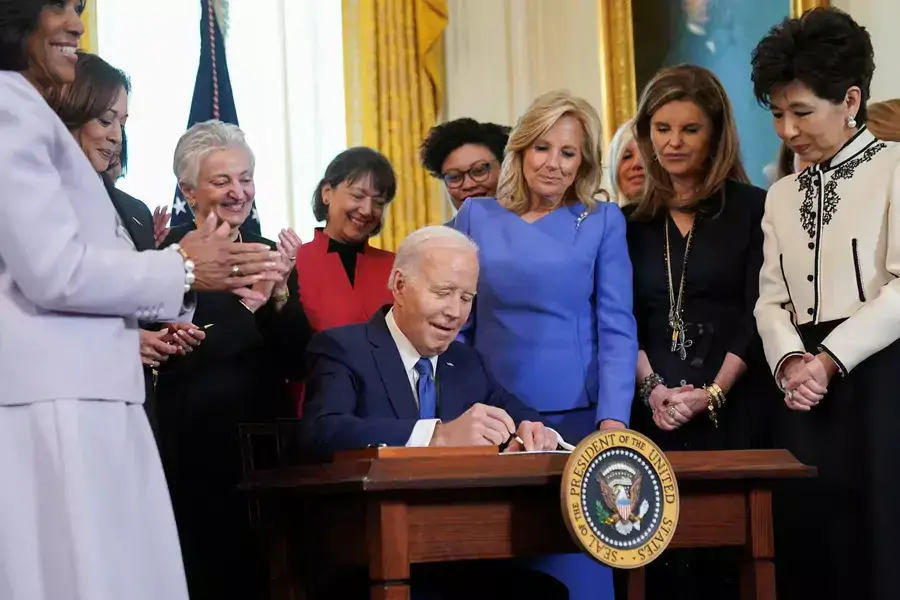Women Voters’ Pivotal Role in Electing the Next U.S. President

Women voters will play a pivotal role in determining the outcome of the 2024 U.S. presidential election. Women comprise the largest group of registered voters, and they tend to turn out at high levels to vote, as 68.4 percent of them did in the 2020 election. The question is, where will women throw their weight?
While former President Donald Trump is leading in many polls, the latest Quinnipiac poll shows President Joe Biden in a dead heat with Trump. In that poll, Biden captured 58 percent of the women’s vote, a five-point gain over the last Quinnipiac poll in December. Trump’s support from women declined by five points to 36 percent. That puts Biden ahead of his 2020 performance when he won 55 percent of the women’s vote, compared to 44 percent of women who voted for Trump.
More on:
Black and Hispanic women voters provided Biden his winning edge in 2020, as 90 and 69 percent those blocs respectively voted for him. In contrast, Trump still retains the loyalty of a majority of white women, who form the largest single bloc of the electorate at 40 percent, and the largest subgroup of women voters.
But Trump’s support could be softening among white women voters given the rising challenges to reproductive rights. Trump’s share of the white women vote in 2020 actually increased from 2016, when he garnered 39 percent. However, the recent South Carolina Republican primary indicated that Trump could be losing some of them. According to exit polls, a shocking 43 percent of women voted for Nikki Haley, despite the fact that Trump was widely forecast to win that contest by a significant margin. That signals a willingness to cast a protest vote against Trump (and likely some loyalty to their former state governor). Deep-red South Carolina will certainly not cross over to vote Democratic in November, but it may mean that some women are turned off enough by Trump to refrain from voting for him.
Women’s rising discomfort with Trump could be due to several factors, including a jury finding him liable for sexual assault of E. Jean Carroll in a civil case and the imposition of an $88 million penalty by two juries. In addition, he continued to defame the plaintiff during and after the trial. He also repeatedly belittled and made racist and false comments about Haley, his own ambassador to the United Nations. Finally, the abortion issue could have opened a seam even in deep red South Carolina. While 51 percent of South Carolina Republicans support a total or near total abortion ban, significant differences could nonetheless exist—including a reluctance to back a 15-week national abortion ban that Trump has pledged to seek. According to South Carolina exit polls, abortion was the top issue for 58 percent of those who voted for Haley, who has repeatedly warned her party that the votes for a national ban do not exist.
It has become clear that abortion rights are a significant issue animating voters in the battleground states that will determine the outcome of the election. The success of state-level measures defending abortion rights in Kansas, Michigan, Ohio, and elsewhere suggests that significant support for abortion and reproductive rights exist among women and men in red and purple states.
Abortion is far from the only issue on women voters’ minds, of course, although the stories of women facing life-threatening decisions continue to galvanize attention around the issue. Economic concerns predominate across the electorate, and younger voters in particular, including younger women, could choose not to vote for Biden over differences regarding his approach to the Israel-Hamas war. A third-party candidate in battleground states could also pose a significant challenge to Biden’s reelection bid if the margins are close.
More on:
Another important subgroup is independent voters, who represent 43 percent of the total electorate; they are roughly divided between those who lean Republican and Democratic. The majority of independents identify as moderate or liberal, rather than conservative, including on social issues, according to the Pew Research Center. That suggests Biden could find some crossover votes if Republican leaners perceive Trump’s positions as too extreme. He will certainly need to retain most of the Democratic leaners to win.
Biden acknowledged the importance of women’s votes in his State of the Union address, and the campaign is giving it new priority with Vice President Kamala Harris leading the charge.
Turnout rates for women have a very good chance of reaching a historic high, not just due to the overturning of the fifty-year-old right to an abortion, but also because that ruling has been followed by an avalanche of actions that many women view as direct attacks on their rights and autonomy. These include state-level abortion bans and restrictions in twenty-four states, court rulings that prevent women from urgently needed abortions to protect their health, efforts to ban the abortion drug mifepristone and limit birth control, and laws that would prosecute women who leave states for abortion care and those who help them. The Alabama Supreme Court decision that frozen embryos are persons caused providers to suspend in vitro fertilization treatments. All of this could lead to a “blue wave” far exceeding the turnout in the 2022 midterms, and with it the possibility that the next president will owe his presidency to women turning out to express their views.
This post was written for the Council on Foreign Relations’ Renewing America initiative—an effort established on the premise that for the United States to succeed, it must fortify the political, economic, and societal foundations fundamental to its national security and international influence. Renewing America evaluates nine critical domestic issues that shape the ability of the United States to navigate a demanding, competitive, and dangerous world. For more Renewing America resources, visit https://www.cfr.org/programs/renewing-america and follow the initiative on Twitter @RenewingAmerica.
 Online Store
Online Store